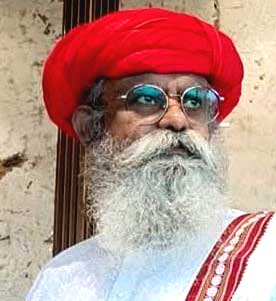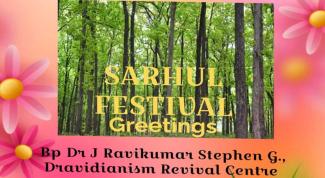Sarhul: Introduction: Sarhul is a vibrant spring festival celebrated in Jharkhand, marking the beginning of the new year. Observed for three days, starting from the third day of the Chaitra month, it holds deep significance for the Kurukh / Oraon speaking Dravidian community.
The name "Sarhul" likely originates from the Tamil word “Cālam” (சாலம்), which refers to trees and flowers. This connection is particularly relevant because the festival revolves around the Sal tree (Shorea robusta), known in Tamil as Kuṅkiliyam (குங்கிலியம்) or Attam (அட்டம்).
Rituals and Traditions:
During the celebrations, young people venture into nearby forests to gather Sal flowers (see the 2nd picture) and catch crabs and fish. Accompanied by the rhythmic beats of the Dhol, Nagara, and Mandar (refer to the 3rd & 4th images), the community makes its way to the sacred Sarna groves—dense forests of Sal trees (see the 5th picture). There, they offer prayers to the Sal tree (refer to the 6th & 7th images) and its blossoms, known as Shalai.
The village priest, who officiates the rituals, is traditionally called ‘Pahan’ (see to the 8th picture) and, in some cases, ‘Laya’ or ‘Deuri.’ These terms appear to have linguistic roots in Tamil, corresponding to the words ‘Pakaṉ’ (பகன்) / ‘Pākaṉ’ (பாகன்) / ‘Pāṅkaṉ’ (பாங்கன்), ‘Ilayam’ (இலயம்), and ‘Turi’ (துரி). Tamil literary references further support this linguistic connection:
1. ‘Pakaṉ’ (பகன்) – In ‘Thirukkovaiyar’ (184), the word refers to the sun¹. Since Sarhul symbolizes the union of the Earth and the Sun, this etymology aligns well with the festival’s theme.
2. ‘Pākaṉ’ (பாகன்) – In ‘Kanthapuranam’ (98)², the term describes someone who has attained moral or spiritual maturity (பக்குவம் பெற்றவன்). In ‘Thevaram’ (1172, 9), it refers to a companion or partner (“ஒரு பக்கத்திற்கொண்டவன்” (oru pakkathir-kondavan) – someone standing by one’s side.
Similarly in a Tamil slang⁴, ‘Pāṅkaṉ’ (பாங்கன்) is used for an agent or facilitator, which is fitting, as a priest serves as an intermediary between devotees and the divine.
3. ‘Ilayam’ (இலயம்) – This word signifies a divine state of knowledge and absorption (இரண்டறக்கலக்கை), resonating with the Kurukh term ‘Laya.’ As a priest imparts spiritual wisdom and attains a trance-like state during worship, the connection is meaningful.
4. ‘Turi’ (துரி) – In ‘Thirumanthiram’ (2454), it represents searching or seeking⁵ (தேடுதல்), with the verb form துருவு (thuruvu). A priest, being a spiritual seeker with deeper insights in spirituality than the laity, aligns with this concept.
The Tamil Connection to the Sal Tree:
The Tamil name for the Sal tree is derived from its resin, known as Sal dammar (refer the 9th image) or Indian dammar, which is used as an astringent in Ayurvedic medicine and burned as incense. In Tamil, this resin is called Kuṅkiliyam (குங்கிலியம்), a name that ultimately became associated with the tree itself.
Khaddi Festival: A Linguistic Bridge:
Among the Kurukh people, the Sarhul festival is known as the Khaddi festival, meaning “flower festival” in the Kurukh language. Kurukh, a Dravidian language, shares deep linguistic roots with Tamil, and the word ‘Khaddi’ likely originates from the Tamil word “Kaṭi” (கடி). Several references in Tamil literature support this connection:
1. ‘Kaṭi’ as Fragrance: – In Tamil Sangam Literature ‘Kalithogai’ (45), the phrase “கடிசுனைக் கவினிய காந்தள்” describes fragrance (Kaṭi), which aligns with the Sal tree’s production of dammar, a resin used in incense.
2. ‘Kaṭi’ as a Wedding Union: – In Tamil Sangam epic, ‘Manimekalai’ (18, 98), ‘Kaṭi’ refers to a wedding⁶. The Sarhul festival symbolically reenacts the sacred union of the Sun and the Earth, with a village priest and his wife representing these cosmic forces. This connection reinforces the linguistic and cultural link.
3. ‘Kaṭi’ as Protection: – In Tamil Sangam poem ‘Purananuru’ (95, 3), ‘Kaṭi’ is used to signify protection⁷ and safeguarding (காவல்). Since Sarhul is deeply rooted in the worship and preservation of nature, this meaning is highly relevant.
4. ‘Kaṭi’ as Renewal: – In Tamil Sangam epic ‘Cīvaka Cintāmaṇi’ (2739), ‘Kaṭi’ represents newness⁸ and renewal (புதுமை). As Sarhul marks the beginning of a new year, this interpretation perfectly captures its essence.
5. ‘Kaṭi’ as Worship: – In Tamil Sangam literature ‘Paripadal’ (17), ‘Kaṭi’ denotes worship and homage⁹. During Sarhul, three roosters are sacrificed in reverence to the Sun, village deities, and ancestors, and families offer food to ancestral spirits (refer to the 10th & 11th images). This ritual meaning of ‘Kaṭi’ mirrors the practices of the festival.
The Bhumij, an indigenous community in Jharkhand, West Bengal, and Odisha, also celebrate Sarhul under the name ‘Hadi Bonga’, further linking it to the Tamil word Kaṭi.
The Deeper Meaning of Sarhul:
The very name Sarhul itself is revealing. It is composed of two elements: Sar + Hul. As discussed earlier, ‘Sarhul likely originates from the Tamil word ‘Cālam’ (சாலம்). The second component, ‘Hul’, denotes ‘collective gathering’ or ‘grove.’ Tamil offers numerous words related to forests, such as ‘Kā’ (கா), ‘Kāṭu’ (காடு), ‘Kāṉ’ (கான்), ‘Kaṭam’ (கடம்), ‘Kaṭaṟu’ (கடறு), ‘Kallakam’ (கல்லகம்), ‘Kavaṉam’ (கவனம்), ‘Kaḷari’ (களரி), ‘Kāṇṭakam’ (காண்டகம்), ‘Kāl’ (கால்), and ‘Kāṉam’ (கானம்). This suggests that ‘Hul’ represents the collective journey into the sacred forest of Sal tree, a core aspect of the festival.
A Festival of Unity:
Despite belonging to a non-Dravidian linguistic group, the Ho and Santal tribes also celebrate this festival, calling it ‘Baa Parab’ and ‘Baha Parab’, respectively. This shared cultural tradition unites them with the Kurukh/Oraon people and, more broadly, with the Dravidian heritage. It echoes Babasaheb Dr B R Ambedkar’s assertion that Tamil, and by extension Dravidian languages, were once spoken across the Indian subcontinent before the arrival of the Aryans.
Conclusion:
Sarhul is more than just a festival; it is a testament to the deep-rooted cultural and linguistic ties between various indigenous communities and the Dravidian heritage. It embodies the harmony between humanity and nature, celebrating the sacred bond between the Earth and the Sun. As we honor this tradition, we recognize its role in uniting diverse peoples under a common cultural umbrella.
🎊 Happy Sarhul Festival 🎊! ❤💐🙏🏽
Bp Dr. J Ravikumar Stephen G.
Founder,
Dravidianism Revival Centre
Notes:
1. “பகன்றாமரைக்கண் கெடக்கடந்தோன்” (paganramaraikkan kedakkadanthon).
2. “பவத்திடை மூழ்கும் பாக ரல்லவர்” [pakkuvam perravan. Pavathidai muzhkum paga rallavar] (கந்தபுராணம். அடிமுடி. [kanthapuranam. Adimudi.] 98).
3. “நாரி பாகன்” [nari pagan] (தேவாரம் [thevaram] 1172, 9).
4. “இவன் விளையாட்டுக்கெல்லாம் பாகன்” [ivan vilaiyattukkellam Pāṅkaṉ.] In this expression the word ‘Pāṅkaṉ’ (பாங்கன்) is used to refer an ‘agent’ – காரியத்துணை செய்வோன் (kariyathunai seyvon).
5. “துரியவல்லார்க்குத் துரி சில்லை [theduthal. Thuriyavallarkkuth thuri sillai] (திருமந்திரம். [Thirumanthiram.] 2454).
6. “கன்னிக்காவலுங் கடியிற்காவலும்” (மணிமேகலை, 18, 98).
7. “கடியுடை வியனகரவ்வே” (புறநானூறு, 95, 3).
8. “புதுமை கடிமலர்ப் பிண்டி (சீவகசிந்தாமணி. 2739).
9. “வேலன் கடிமரம்” (பரிபாடல், 17).
#Sarhul #SpringFestival #KurukhCulture #DravidianHeritage #IndigenousTraditions #SalTree #TamilConnections #CulturalUnity #JharkhandFestivals #AncientRoots



